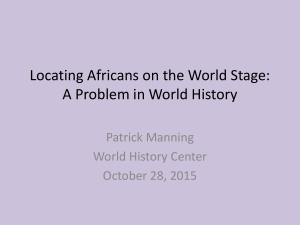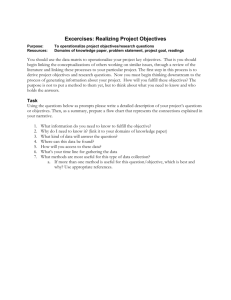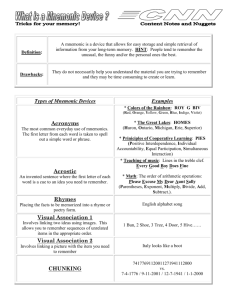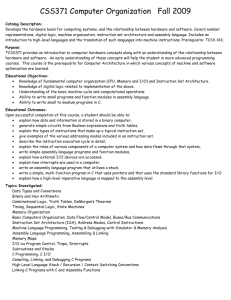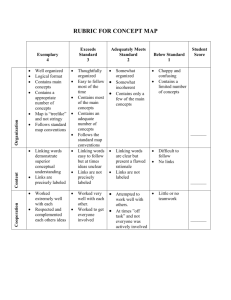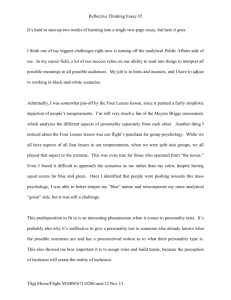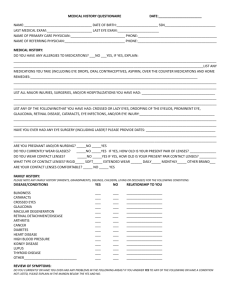Organization
advertisement
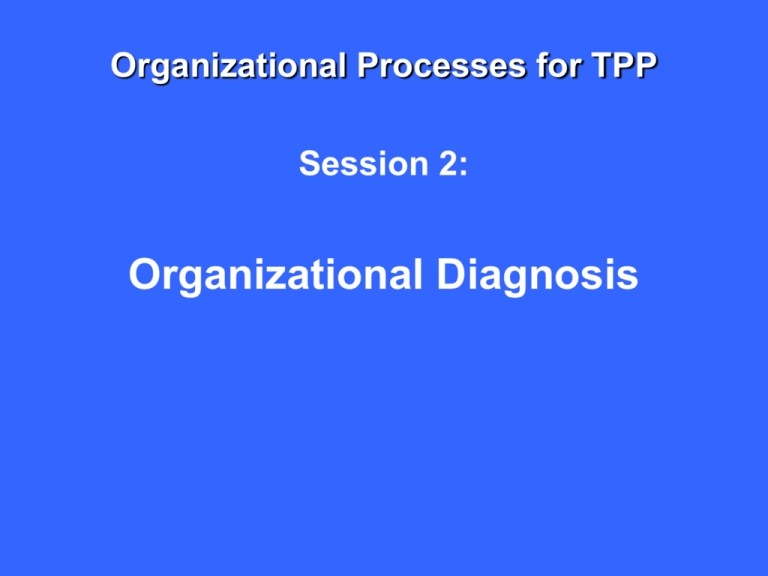
Organizational Processes for TPP Session 2: Organizational Diagnosis Session Design(3 hour) • Three Perspectives for Analyzing Organizations (45min.) • Application - Dynacorp Case (Three Clusters for Analysis)(60min.) • Use of Three Perspectives in Industry Analysis and other Technology Policy challenges(15 min.) • Skill Module(30min.) • Industry Clusters(30min.) Tree Perspectives on Organizations Organization as Strategic Design • Key Concepts: Formal structures (the “boxes”), systems, information, accounting, incentive, etc.) • Key Processes: Grouping( differentiation), linking (integration) • View of the Environment: Opportunities & threats, resources • Role of the Manager: “Organizational architect,” strategist • Stimuli for change: Lack of internal congruence, lack of “fit” between organization & strategy, between organization &environment • Barriers to Change: Inadequate analysis or information Grouping & Linking • Grouping - By activity – e.g. functional - By output – by service or product (SBUs) - By market – user, customer, geography • Linking - Reporting structure - Information systems - Planning systems - Managerial role – liaison, integrator - Cross unit groups – informal/temporary groups (e.g. task forces, projects), formal structures (e.g. councils, steering committees -Shared socialization processes – cultivation of informal information nerwork Summary Points: Strategic Design Perspective • Need for Fit - Environment, strategy, Structure • Need for Linking - Integration Structures • Structures Necessary - Integration only occurs when INTEGRATING • PROCESSES WORK WELL -Structures create interests, power, identities – analyzing these require political & cultural lenses Organization as a Political System • Key Variables: Power & influence, interests, dominant coalition • Key Processes: Conflict, negotiation • View of the environment: Stakeholders • Role of the manager: Forging coalitions, identifying and leveraging interests, negotiating • Stimuli for change: Shifts in dominant coalition, in power of stakeholders • Obstacles to change: “Entrenched interests” The New Organization & Sources of Conflict • Flat -Responsibility exceeds authority • Flexible -Change mean sealing with resistance • Network -Cross-function collaboration mean conflict at site of decision-marking • Diverse/Global -challenges of working across differences Analyzing Interests • Substantive - Costs, resources, quality, time • Organization - Protect function, promote career, look good,save face • Relational - Maintain relationships, short v. long term • Individual - Commitment to work, personal life, community Sources of Power • Formal Authority: Power of position • Control of Scarce Resources: Access to resources (fund, skills, knowledge) that others depend on: E.g.: - Information is power—so hold on to it - Information sharing promotes learning; filling “structural holes” (linking two groups who need info) enhances power • Control of Decision-marking: Influence over premises, processes, objectives, outcomes • Ability to Cope with Uncertainty: Environment (financial, markets, raw materials) &operational (breakdowns) • Alliances/Network: Ability to call on powerful others • Symbolism & Management of meaning: Ability to define reality for others; style/charisma Forms of Negotiations/Change Negotiations: - Forcing: Domination, the use of power and position; hard bargaining; “Position Based” - Fostering: problem solving, working toward integrative outcomes; “Interest Based” Smoothing/Avoidance: Gloss over differences, play down disagreements, let problem pass, avoid the other - Compromise (split the difference), problem solving (work for an integrative outcome) Conflict Management • Manager as arbitrator - Makes decision when other can't agree • Manager as Mediator - Help others resolve their differences voluntarily • Manager as Facilitator - Assists others in addressing their underlying interests • Manager as Negotiator - Represents interest of his/her group/unit/organization Manger as all of the aove Summary Points: Political Perspective • Political usually lie under the surface • Managing politics requires legitimating difference • To analyze & Manage ask: - Who are the stakeholders? - Who are their interests? - Who has power? - How much power be changed: allies & blockers? -What option are possible for achieving interests? -What happens if interests are not met? • Manager must to a skilled Negotiator & Conflict Resolver Organization as Cultural/Social System • Key Variable: Shared mental maps, organizational culture (artifacts, values, basic assumptions) • Key processes: Meaning and interpretation, legitimation, rhetoric, vision • View of environment: Social and cultural network • Role of the manager: Articulating vision ,managing the culture • Stimuli for change: Challenges to basic assumption contending interpretations • Impediments to change: Dominant culture Culture Diefined Share understandings a given group has developed to deal with the problems of external adaptation and internal integration. • • • • • Historical: Passed across generations Moral force: Normative not utilitarian Associated with stability of a group “The way we do things around here” Differentiating/identity device: Relative to other groups • Associated with the intensity of common problems faced by members • Changes across time (usually small) related to the degree the internal and external environment shift What is Organizational Culture? Visible Artifacts Visible organizational structures and processes (hard to decipher) Stated Values Strategies, goals, philosophies (espoused justifications) Underlying Assumptions Unconscious, taken for granted beliefs, habits of perception, thought, and feelings (ultimate source of values and action) Dynacorp • See Dynacorp Org Charts, pp. 98-99 of text • Divide into three groups according to the perspective you want to work on: -Meet, discuss what data, info you will look for to answer two questions: 1. What’s the problem here? 2. What actions would you recommend? WHEN YOU REPORT OUT STAY IN YOUR PERSPECTIVE! Dynacorp & 3 Lenses: Lessons • 3 different lenses; 3 different sets of actions • Use lenses to differentiate – not integrate or homogenize problem definition/diagnosis • Key skills: Look & read a situation from each o the 3 Perspectives • Then devise strategies that draw on all 3 • Beware of consultants or parties in an organization with limited vision!!
